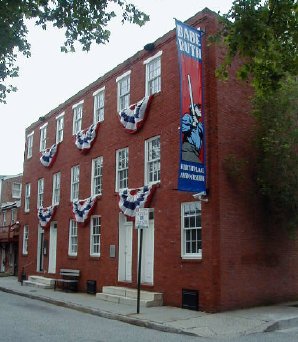


 |
History
Ridgely's Delight is located on what was once a Susquehannock Indian path. During the Federal period (1790-1828), the main highway from Washington to Philadelphia, now known as Washington Boulevard, passed through the neighborhood.
Ridgely's Delight was named after the plantation of
Colonel Charles Ridgely, who occupied the open land southwest of the city's
original boundaries. Ridgely acquired the estate as dowry in 1667 through
his marriage to Rachael Howard. In 1732, this land, originally known as
Howard's Timberneck, was combined with another property known as Brotherly
Love, resurveyed and named Ridgely's Delight. In 1735, Ridgely began leasing
parcels of land in Ridgely's Delight.
of
Colonel Charles Ridgely, who occupied the open land southwest of the city's
original boundaries. Ridgely acquired the estate as dowry in 1667 through
his marriage to Rachael Howard. In 1732, this land, originally known as
Howard's Timberneck, was combined with another property known as Brotherly
Love, resurveyed and named Ridgely's Delight. In 1735, Ridgely began leasing
parcels of land in Ridgely's Delight.
The earliest houses in Ridgely's Delight date
from about 1804. Most of the development of Ridgely's Delight
occurred between 1816 and 1875, especially during the 1840's
and 1850's. The mid-century development is mostly due to
the establishment of the Universityof Maryland in 1812 and the growth
of heavy industrial areas nearby, such as the B&O Railroad Yards and
Winan's Locomotive Works. Ridgely's Delight reflected the character of
these nearby employment centers, with professionals and blue collar workers
part of its diverse neighborhood.
Our neighborhood reflects the streetscape of Baltimore's first period of expansion in the early
19th century. Late Federal houses of two-
or two and one-half-stories originally housed craftspeople. Three-story, corniced, Italianate
houses were built for the middle and upper classes toward the end of the
19th century. These homes once housed doctors, dentists, and lawyers,
earning Washington Boulevard the nickname "Professional Row"
during the turn of the century. The neighborhood also features some store-front
buildings, a few late 19th century industrial buildings, and homes with postage stamp front yards
that are set back from the street.
In the 1970s, gradual urban decay resulted in a resurgence of lower income residents in the area until the City's $1 homesteading program, launched in 1973, helped rebuild Ridgely's Delight to its former splendor without displacing its original residents.
Babe Ruth, our most famous son
George Herman "Babe" Ruth is number one on The Sun's list of top Maryland athletes and is known as the greatest baseball player of all time for his remarkable skills as both a pitcher and a batter. He was born on the second floor of 216
Emory Street on February 6, 1895.
The Babe Ruth Birthplace and Official Orioles Museum was the home of Babe's maternal grandfather, Pius Schamberger, a German immigrant who made his living as an upholsterer. Babe's mother and father, Kate and George Sr., lived above the saloon they owned and operated on Camden Street, now short-center field of Oriole Park at Camden Yards. Mrs. Ruth made the short journey to her father's home to give birth to Babe.
The complex was saved from demolition in 1969 by a group of concerned citizens and opened to the public in 1974 as the only birthplace of an American athlete to be designated a national historic landmark.
History Comes Alive
For such a small area, Ridgely's Delight has a long and colorful history. George Washington slept here, Babe Ruth was born here and runaway slaves found refuge here. Read historical anecdotes about the neighborhood provided by current and former residents.
neighborhood info | residents' info | neighborhood businesses | contact us